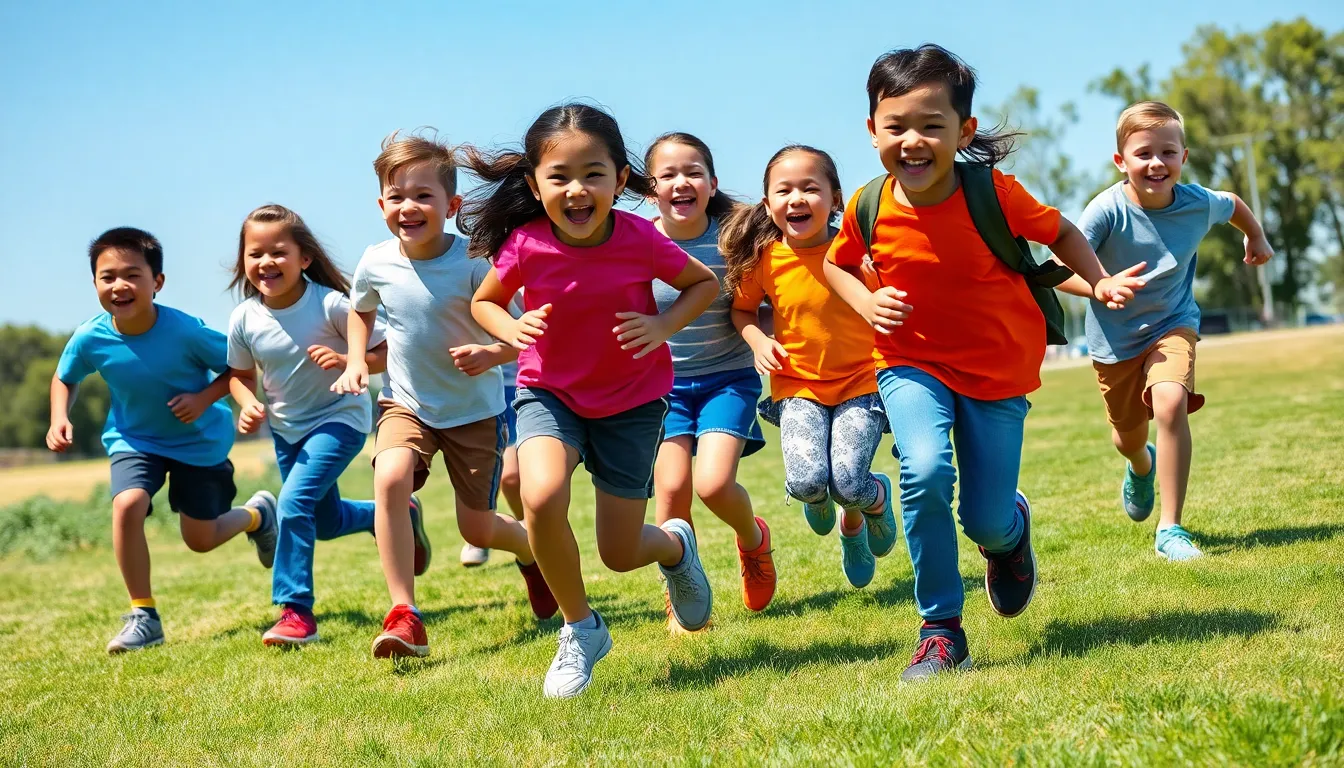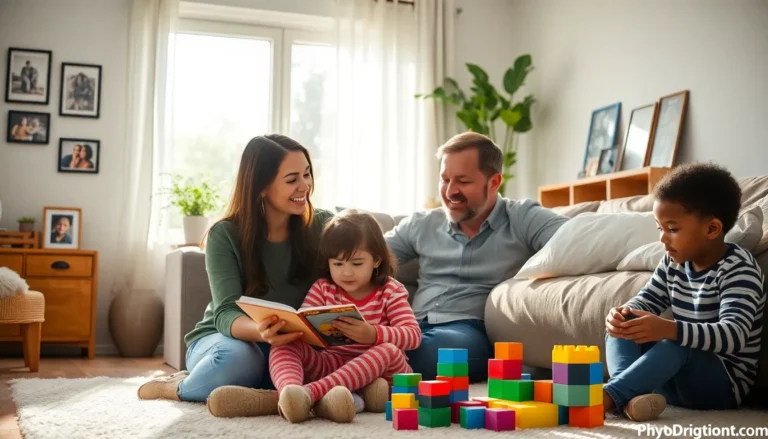Elementary P.E. games are more than just a way to keep kids active; they’re the secret sauce for building friendships, teamwork, and a love for movement. Picture a gym buzzing with laughter, where kids are dodging balls, racing to the finish line, and showing off their best dance moves. These games not only burn off that endless energy but also spark joy and creativity in every child.
Table of Contents
ToggleOverview of Elementary P.E. Games
Elementary P.E. games encompass a range of activities designed to engage children while promoting physical fitness. These games encourage cooperation, communication, and competition within a fun environment. Various activities help develop motor skills, coordination, and balance.
Tag activities like tag, capture the flag, or dodgeball not only keep children active but also enhance their social interaction. Children learn the significance of teamwork during these games as they strategize and work together to achieve common goals.
Traditional sports modified for younger players, such as soccer or basketball, allow kids to experience organized play. Simplifying the rules ensures that all participants understand the game, maximizing enjoyment and participation.
Incorporating non-traditional activities like obstacle courses or parachute play adds variety and excitement. These games stimulate creativity while building strength and agility through unique challenges.
Safety remains a priority during P.E. games. Teachers should assess the environment and equipment to ensure the playground is secure. Regularly reinforcing rules about fair play and respect cultivates a positive atmosphere where all children feel included.
Ultimately, elementary P.E. games serve as a foundation for lifelong healthy habits. Engaging children with enjoyable activities fosters a love for physical activity, setting the stage for a more active future.
Importance of Physical Education
Elementary physical education plays a crucial role in shaping a child’s development. Engaging in P.E. games lays the groundwork for healthy habits and overall growth.
Benefits for Physical Health
P.E. games directly contribute to improving physical health. Enhanced cardiovascular fitness occurs through activities like tag and dodgeball. Increased strength and coordination develop as children navigate obstacle courses and participate in group games. Balancing fun with fitness, these games encourage regular physical activity, reducing the risk of obesity. Flexibility also improves as kids stretch and move in diverse ways. Developing motor skills lays the foundation for proficiency in various sports, promoting a lifelong appreciation for exercise.
Benefits for Social Skills
P.E. games foster essential social skills in children. Cooperation becomes evident as kids work together towards a common goal, particularly in team-based activities like capture the flag. Effective communication flourishes through strategizing and problem-solving, enhancing relationships. Conflict resolution skills strengthen as children learn to negotiate during games. Building friendships often stems from these shared experiences, creating a supportive environment for social growth. Additionally, understanding the importance of teamwork cultivates respect and empathy among peers, essential components of healthy social interactions.
Popular Elementary P.E. Games
Elementary P.E. games include both traditional and modern variations that engage children in physical activity while promoting social skills. These activities encourage teamwork and fun, making them essential for overall development.
Traditional Games
Tag games create excitement and physical activity, with variations like freeze tag where players must avoid being tagged while helping frozen friends. Capture the flag offers strategic teamwork as players try to capture the opposing team’s flag without being tagged. Dodgeball focuses on agility and quick thinking as players throw soft balls to eliminate opponents. Relay races enhance speed and cooperation through team-based competition. These traditional games support motor skill development while fostering friendships among players.
Modern Variations
Modern variations of P.E. games incorporate elements of technology, fitness, and creativity. Obstacle courses challenge children through a combination of running, jumping, and climbing, promoting strength and agility. Parachute play encourages teamwork as kids work together to create waves and keep balls afloat. Dance-based games introduce rhythm and coordination, allowing children to enjoy movement while learning basic dance steps. Fitness games, such as the use of interactive apps, motivate kids to engage in physical activity, blending fun with technology.
Tips for Implementing P.E. Games
Effective implementation of P.E. games enhances the overall experience for children. Focus on preparation and adaptability for successful activities.
Essential Equipment
Identify necessary equipment to ensure games run smoothly. Basic items include cones, balls, ropes, and markers. These tools support a variety of activities while promoting physical fitness. Consider using items like hula hoops and bean bags for added fun. Rotate equipment regularly to maintain engagement and interest among children. Maintain equipment in good condition to ensure safety during active play. Utilize storage solutions to keep the equipment organized and accessible for quick set-up during lessons.
Safety Considerations
Prioritize safety to create a secure play environment. Start by assessing the playing area for potential hazards such as uneven surfaces or obstacles. Establish clear rules about fair play and appropriate behavior during games. Conduct a warm-up session before activities to prepare children’s muscles and reduce injury risk. Encourage children to wear suitable footwear for better grip and support. Provide systematic instructions on game objectives to minimize confusion, preventing accidents. Supervise children closely, stepping in when necessary to address any unsafe behavior or conflicts.
Adapting Games for Different Skill Levels
Adapting games for various skill levels ensures every child participates and enjoys physical education. Modifications enhance gameplay, fostering inclusivity and engagement among all students. For instance, when playing tag, consider establishing different bases that allow less agile players to rest or recover.
Another approach involves adjusting game rules. In dodgeball, limiting the number of players that can be eliminated at one time encourages more interaction, allowing everyone to stay involved. Variations like soft balls for younger children minimize fear and enhance participation, ensuring a positive experience.
Creating smaller game formats also works well. Reducing team sizes encourages more touches of the ball, fostering skill development and confidence. These adjustments benefit those who may struggle within larger teams, allowing them to shine and build their abilities.
Incorporating skill ladders provides children with opportunities for incremental improvement. Organizing drills focusing on fundamental skills, such as throwing or catching, allows teachers to assess individual progress, offering feedback and personalized support. This structured approach caters to varying levels, enhancing overall development.
Personalization of roles can also boost engagement. Assigning leadership positions based on skill can motivate children to perform and develop teamwork. By allowing advanced players to mentor others, everyone benefits from collaboration, strengthening social bonds.
Finally, emphasizing fun over competition maintains a positive atmosphere. Prioritizing enjoyment encourages enthusiasm for physical activity, regardless of skill level. Celebrating individual achievements, such as overcoming challenges, reinforces self-esteem and resilient attitudes towards physical fitness.
Conclusion
Elementary P.E. games play a vital role in shaping children’s physical and social development. They provide a platform for kids to engage in healthy activities while building essential life skills like teamwork and communication. The excitement of these games not only keeps children active but also nurtures creativity and fosters friendships that can last a lifetime.
By incorporating a variety of traditional and modern activities, educators can create an inclusive environment that encourages participation from all students. Adapting games to different skill levels ensures everyone can join in the fun. Ultimately, these experiences instill a lifelong love for movement, paving the way for a healthier future.







